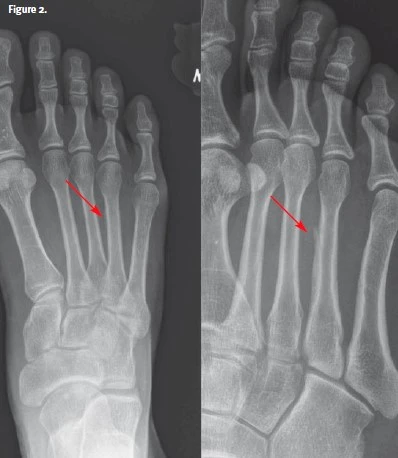Published on
Differential Diagnosis
- Foot tendonitis
- Third metatarsal fracture
- Suspected fourth metatarsal stress fracture
- Second proximal phalange fracture

Diagnosis
The correct diagnosis is a suspected fourth metatarsal stress fracture. The x-ray demonstrates periostitis adjacent to mid/distal 4th metatarsal. Fatigue fractures such as this are common in athletes and those in military service, which is why they are also known as “march” fractures. They may be distinguished from insufficiency fracture, which occurs in abnormal bone. Risk factors include female sex, low bone density, nutritional disorders or deficiencies, long-distance running, inappropriately short recovery time, and inadequate shoes.
What to Look For
- Periosteal reaction/elevation may take up to 2 weeks to be detectable.
- Due to poor radiograph sensitivity, during the first few weeks after the onset of symptoms, x-rays of the affected area may look normal.
Pearls for Urgent Care Management
- Rest and ice are the mainstays of treatment
- Consider a hard-soled shoe or cam boot to help with rest
- Non-steroidal anti-inflammatory drugs are the best agent for pain management
- Consider repeat imaging in 2-4 weeks if diagnosis is unconfirmed at the time of presentation
Download the article PDF: Foot Pain After Hiking
48-Year-Old With Foot Pain After Hiking
1 2
